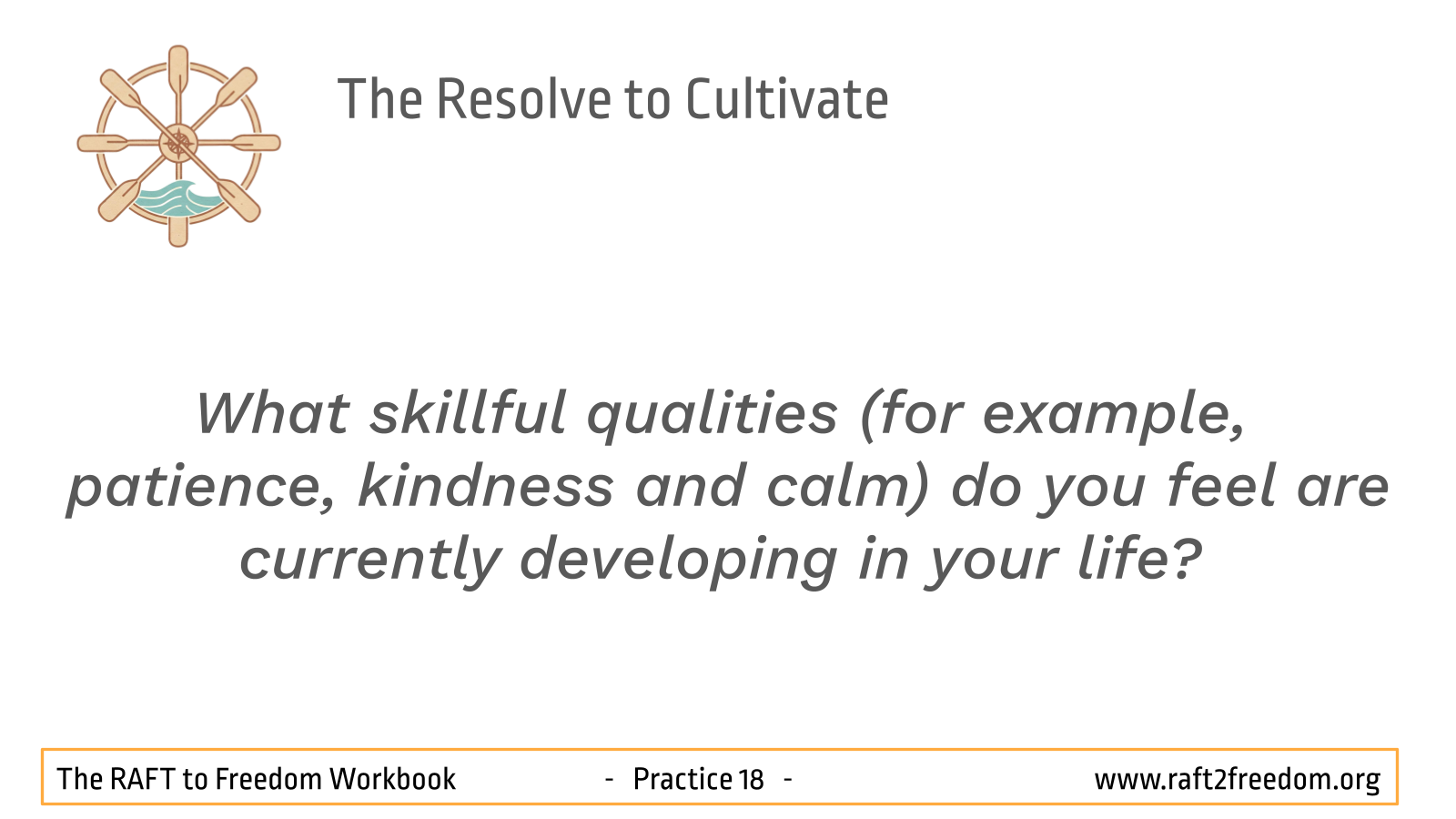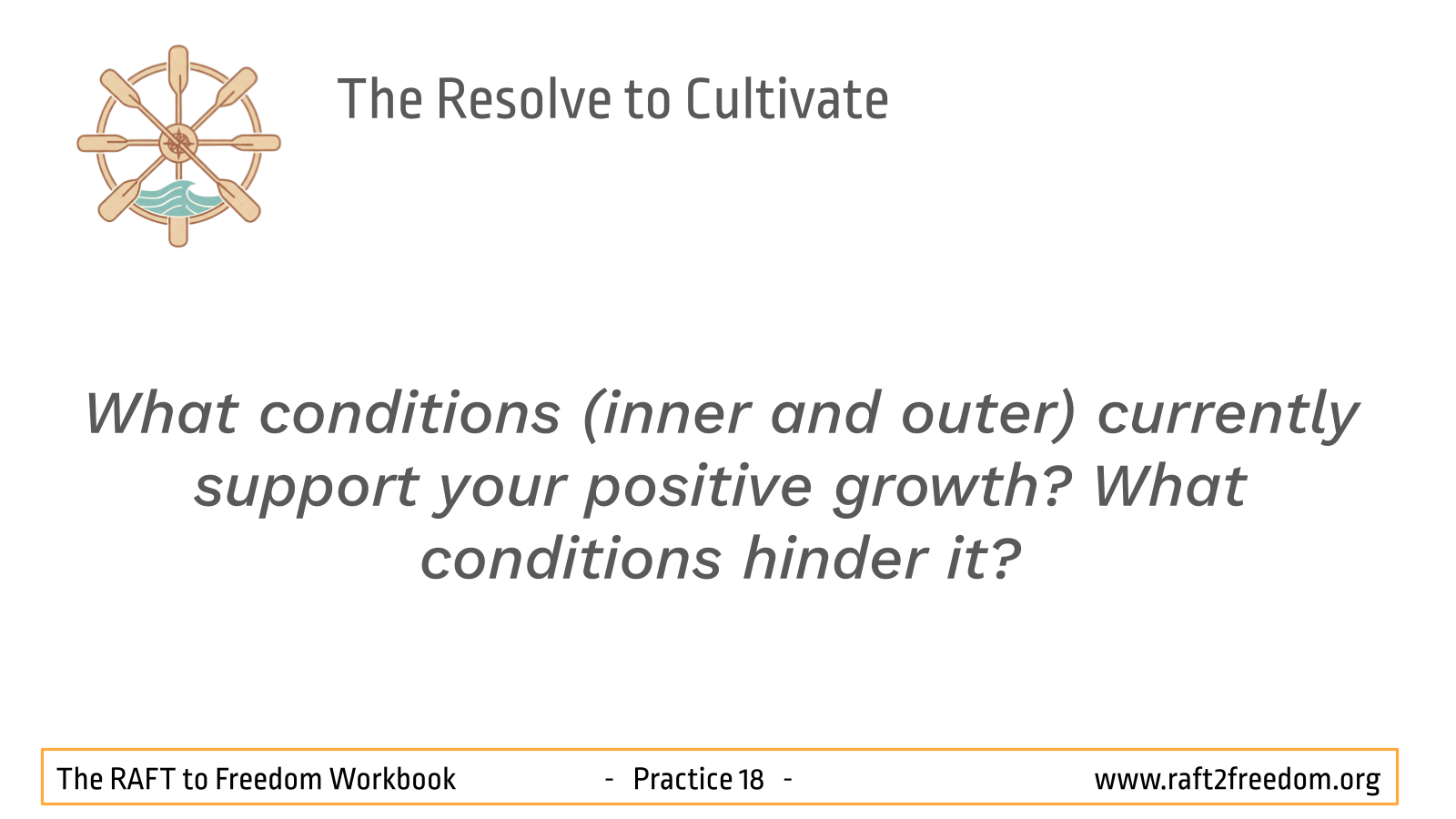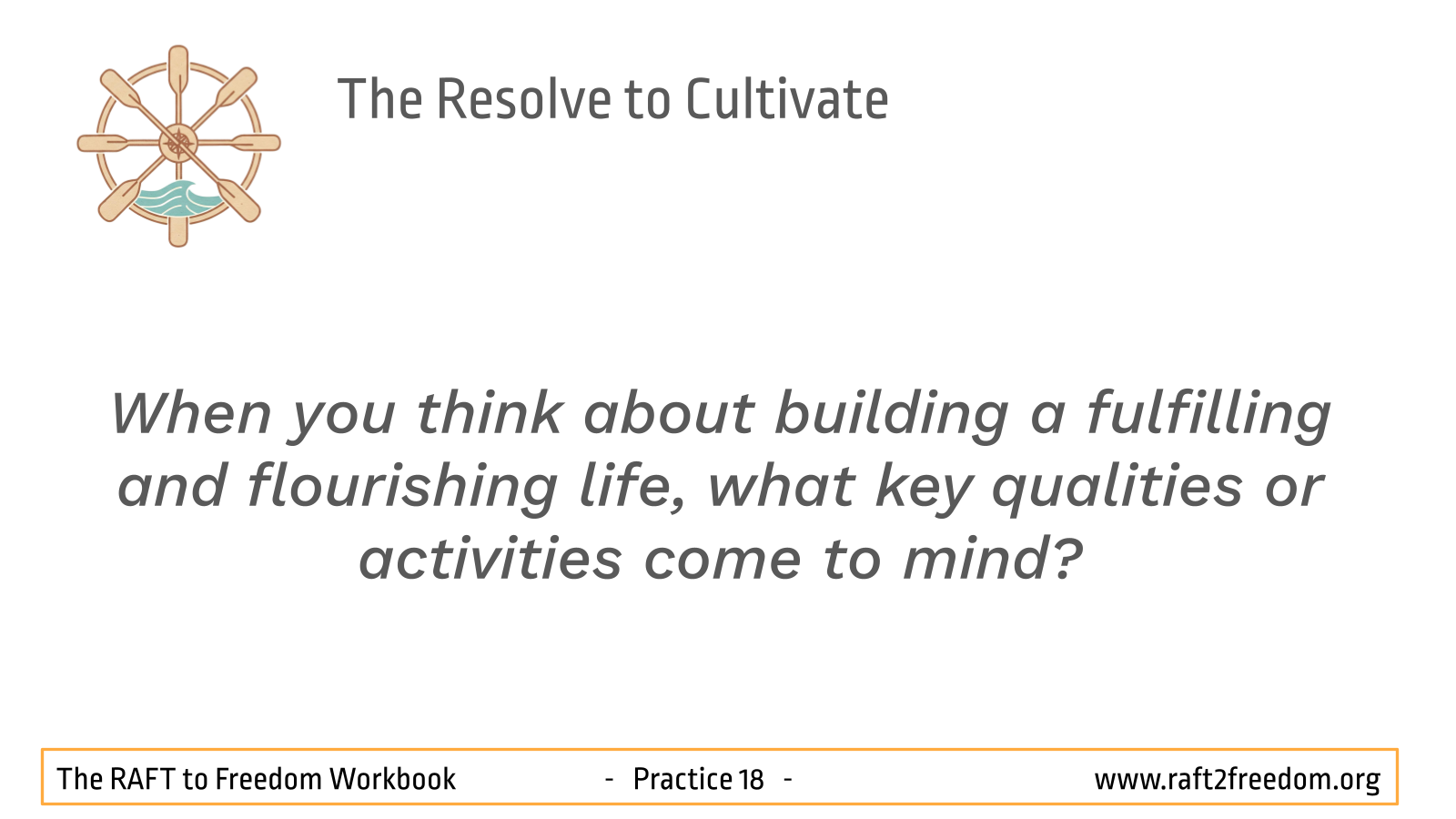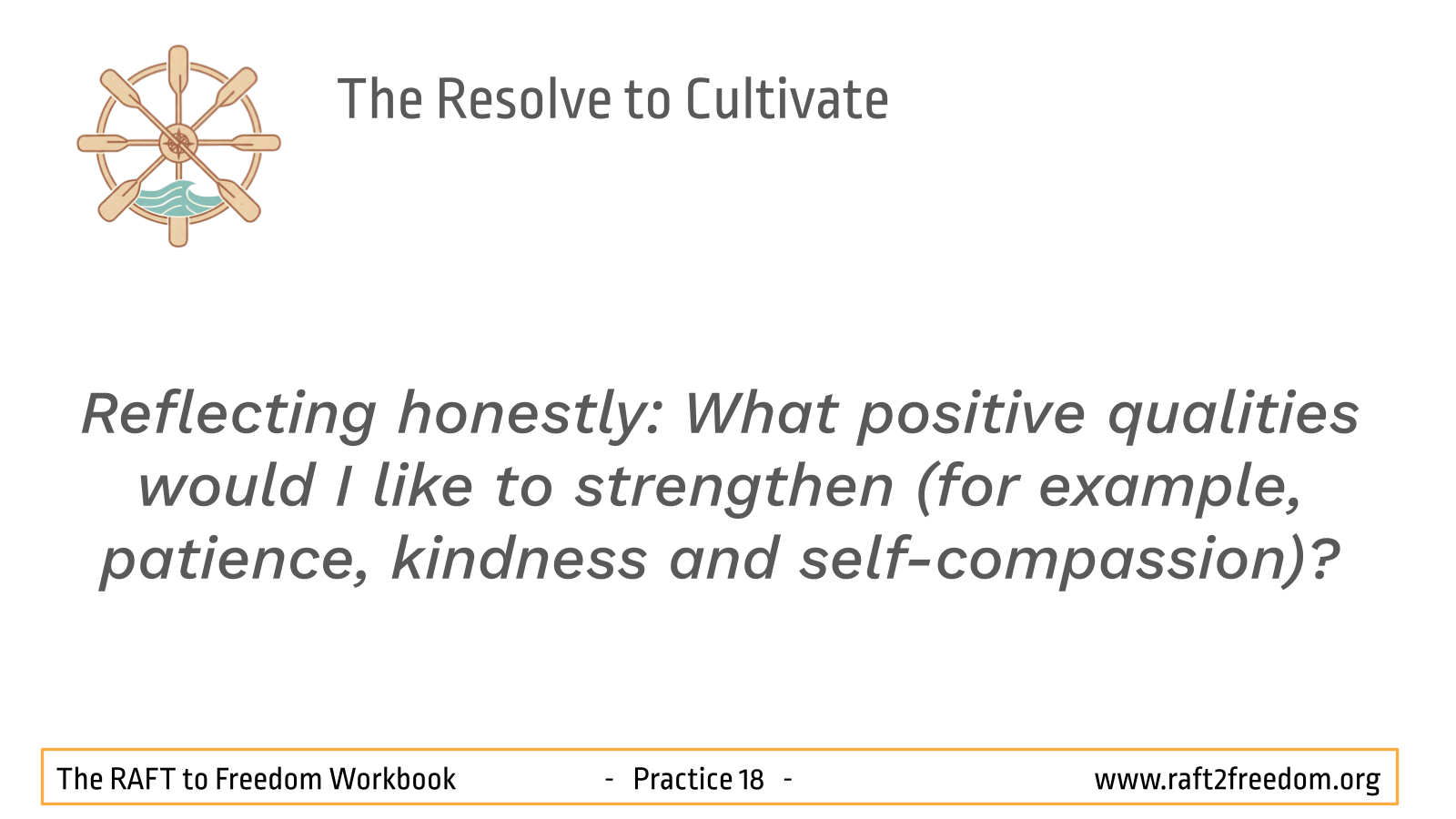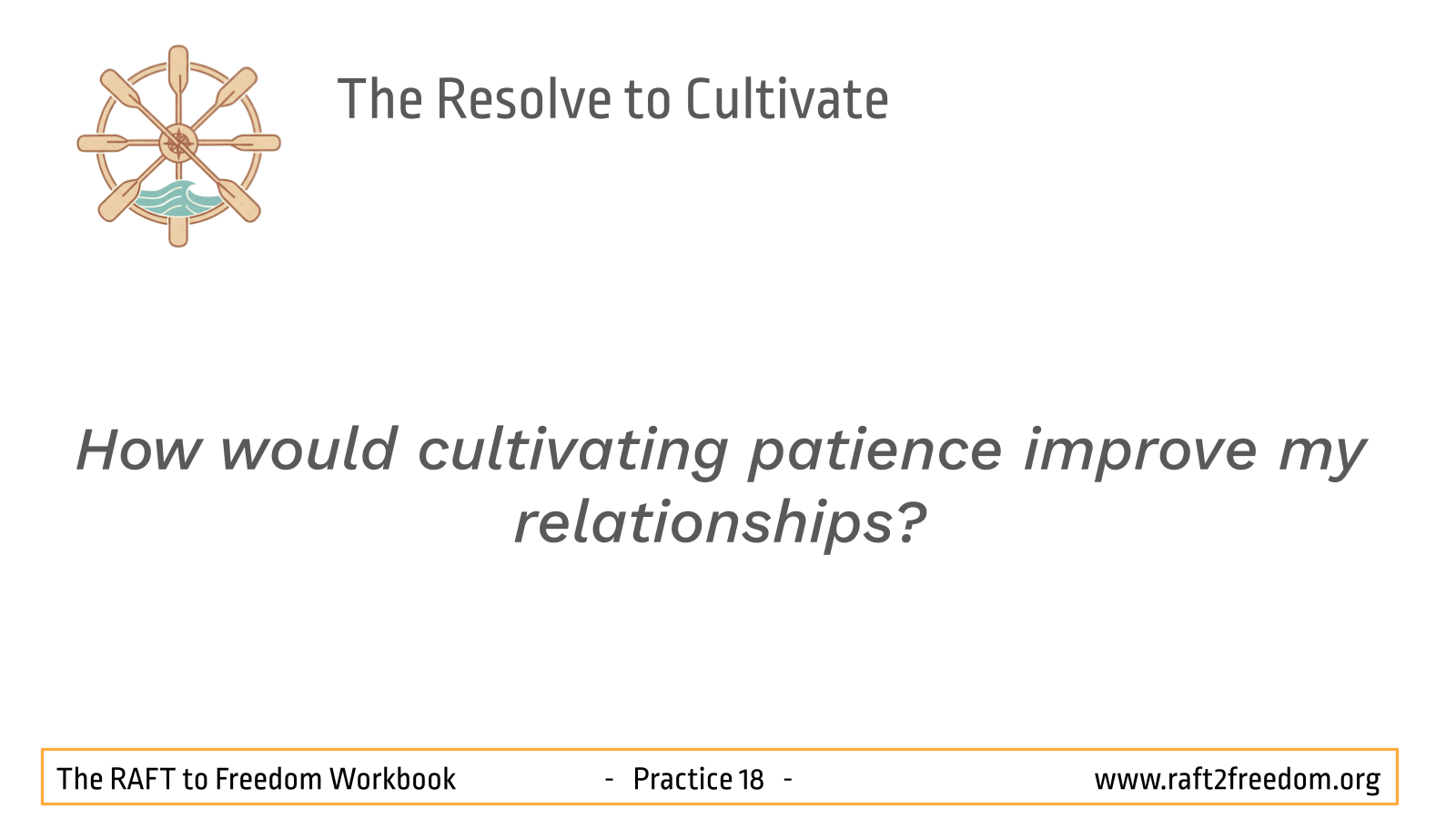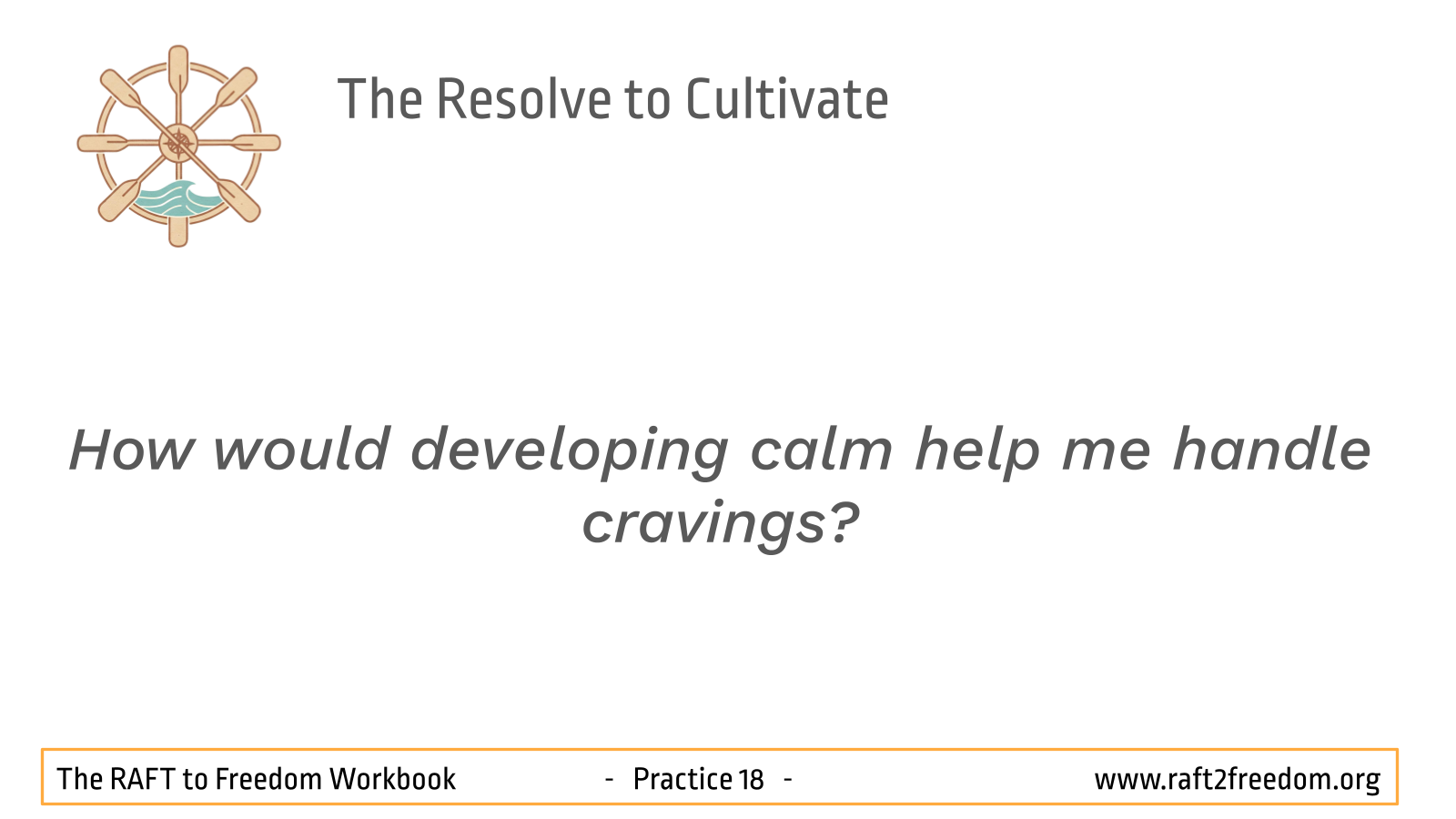Practice 18 – The Resolve to Cultivate Helpful States
“Little by little, drop by drop, a water pot is filled. Likewise, the wise man, gathering it little by little, fills himself with good.”
Dhammapada 122
“Resolve is not about forcing yourself to act, but creating conditions that naturally lead to action. Reorganise your inner and outer life so that your mind and circumstances support what you aspire to achieve.”
Stephen Batchelor

Episode 18 – The Resolve to Cultivate
An AI generated ‘deep dive’ into this aspect of the RAFT to Freedom
Actively nurturing the good
We have explored the crucial resolves of Preventing harm and Abandoning unskillful states. Now, we turn to the proactive, constructive heart of skillful effort:
The third resolve – Cultivating
This vital aspect of our journey to liberation moves beyond simply managing the negative. This is where we actively begin to gather the materials and build the core structures of our raft, moving beyond simply avoiding shipwrecks. It involves consciously and deliberately making an effort to arouse, develop, and nurture positive, skillful qualities and states of mind that are not yet present or not yet fully established. This is where we actively start to build a fulfilling life – a flourishing life, a life reclaimed from cravings, aversions and confusion.
This resolve is about committing to adopting helpful, healthier and creative ways to live, recognising that in many ways, these healthy habits will replace our old unhealthy habits. Gotama (the Buddha) describes this ‘third effort’ as an active development:
“… a practitioner generates desire for the arising of skillful qualities that have not yet arisen; they make an effort, arouse energy, apply the mind, and strive.”
The Buddhist word ‘bhavana’ was originally translated into English as meditation, but this simple translation misses the depth of the concept. Bhavana, with its roots in the ancient Indian languages of Sanskrit and Pali, carries a richer meaning that goes beyond just sitting quietly, a meaning that is subtly different to the English word meditation.
Literally, bhavana translates as development, or cultivation, and producing, particularly in the sense of bringing something into being. In practice, bhavana refers to the intentional cultivation of positive mental states. It’s the process of nurturing qualities like universal friendliness (often referred to as loving-kindness or metta-bhavana) or mindfulness (sati-bhavana) through focused mental effort.
We can think of it like tending a garden. We clear the weeds (our negative thoughts), we nourish the soil (of our minds), and we plant seeds (of positive qualities and attitudes). Bhavana is our ongoing practice of care and cultivation that allows these qualities to blossom.
Here’s why this meaning is important:
- Bhavana is an active process that emphasises the nature of meditation. It’s not about passively observing our thoughts but it’s about deliberately shaping and directing our heart-mind (the Heart’s Compass).
- Bhavana is a holistic development that goes beyond just achieving a calm state. It’s about cultivating a range of positive tools and qualities that help us navigate safely to the far shore and to lasting well-being.
- Bhavana has specificity in that it often appears with other words, for example, Friendliness (or loving-kindness) Bhavana, or Mindfulness (Sati) Bhavana, and in particular, Citta (or heart-mind) Bhavana. These highlight the targeted nature of ‘meditation’ – we’re developing specific qualities, quite often with specific practices to get us to specific destinations.
Bhavana has a purpose, to bring something into existence, to develop, to cultivate – very much in the agricultural sense of planting a seed. Most commonly, what is cultivated is a ‘gathered mind’ (focus) or ‘discernment’ (insight). Interestingly, as we shall see later, ‘meditation’ or ‘bhāvana’ goes beyond developing focus and insight, to help us develop and maintain new wholesome skills, including the capacity to nurture self-love, nourish self-compassion, cultivate self-appreciation, and encourage self-balance.
So, the next time we encounter the word ‘meditation’, we might want to think of it as tending to the garden of our being. It’s not just meditation, it’s our dedicated practice of nurturing the seeds of peace, kindness, and wisdom within our heart-mind.
All of these discussed topics above, we will explore in more detail in future chapters.
As Vince Cullen reminds us, “We are conditioned, and we can be reconditioned – even unconditioned.” This third resolve focuses directly on the positive reconditioning process.
This isn’t about forcing feelings or pretending. As Stephen Batchelor wisely suggests, it is about creating conditions that naturally lead to positive action by creating supportive inner and outer conditions. It requires us to Recognise not only our pain, difficulties and disappointments, but also our potential for growth, and the specific wholesome qualities that would most benefit our ultimate well-being.
Within our RAFT to Freedom metaphor, if Preventing involves avoiding hazards and Abandoning involves patching leaks, then Cultivating is the essential work of actively gathering beneficial new materials and building skillful structures onto our raft. This includes adding strong sails (the four stages of our journey – Recognise, Abandon, Freedom, Train) to catch the winds of wholesome desire, strengthening the mast (developing concentration), and installing reliable navigational tools (cultivating wisdom). It’s about making our vessel not just functional, but resilient, well-equipped, and capable of sailing smoothly towards the safe shore.
Why cultivate the positive?
The journey to liberation is far more than just stopping harmful behaviours. Lasting freedom requires us to actively build a life that feels meaningful and resilient. Cultivating skillful states:
- Providing healthy alternatives: Cultivating positive states and activities, contributes to our genuine well-being and can help to meet our underlying needs (for example, our need for connection, calm and stress relief) in healthy ways.
- Displacing the unskillful: As we cultivate wholesome states, such as kindness and stillness, these states grow stronger and naturally leave less room for their opposites like ill-will and agitation.
- Building resilience: When we cultivate positive emotions like gratitude and compassion, they act as buffers against stress and increase our capacity to navigate challenges.
- Fostering purpose and self-worth: When we engage in activities aligned with our values, we build the self-respect that was eroded by the destructive habits we had previously used to manage our pain, difficulties and disappointments.
Mindfulness simile: The skilful ploughman
Gotama offers a helpful simile to illustrate how we actively cultivate mindfulness and positive mental states, likening this effort to the skilful and diligent work of a ploughman:
“I am a ploughman… ” said Gotama“
My field is faith, my rain is effort,
My plough and yoke are wisdom and mindfulness,
My blade is shame, my bar is mind,
Guarded by truth, my food is liberation.”
In this simile, Gotama reimagines himself as a spiritual ploughman, using qualities like mindfulness as tools to cultivate the field of liberation – a rich metaphor for journey to freedom.
Just as a skilled ploughman or his apprentice, preparing the field, would carefully fix their attention on the plough’s point of entry into the ground, knowing exactly how deep and straight each furrow should be – if they become distracted and look away, the furrow inevitably veers off course – so too, cultivating mindfulness and wholesome states requires continuous, careful, and attentive effort. Momentary distraction can cause us to lose our clear direction, allowing unhelpful thoughts or habits to take root.
This vivid image highlights several key points about our resolve to cultivate positive mental states:
- Continuous effort: Just as the ploughman must maintain steady attention, our cultivation of mindfulness and positive habits requires ongoing, vigilant effort. Moment-by-moment awareness ensures we remain on course.
- Clear intention: The ploughman knows precisely where he aims to go, creating straight and fertile rows. Similarly, our mindful efforts must be guided by clear intentions – knowing exactly which wholesome states we wish to nurture, such as compassion, kindness, patience, and resilience.
- Skilful correction: Even a careful ploughman occasionally drifts off track. The crucial skill is quickly noticing this and gently steering back on course without harsh judgement. This mirrors our practice: when we notice distraction or harmful habits arising, we compassionately redirect ourselves toward wholesome intentions – staying our intended course.
By visualising ourselves as skilful ploughmen in our own inner fields, we actively turn over the soil, perhaps revealing something which had been previously hidden and is now uncovered into the light of day. Remember that if issues arise that you find particularly painful or difficult, it can be wise and beneficial to seek professional help. If nothing untoward is uncovered, we are still preparing the ground for new growth. We understand the delicate and deliberate nature of cultivating beneficial states. Each moment of mindful care sows seeds of resilience and clarity, preparing the fertile ground from which true freedom and lasting well-being can blossom.
How to practice cultivation
Actively nurturing the good involves several steps:
- Identify wholesome qualities & skills: This involves us actively seeking out and cultivating more helpful mind states, qualities and life skills. Practically, this might involve developing new skills, such as:
- Mindfulness and meditation
- Stress management
- Effective communication
- Coping skills
- Problem-solving
- Relapse prevention planning
- Engaging in supportive activities, such as:
- Such as those found in various communities (examples include, Buddhist Recovery Groups, 12-Step fellowships and other support groups).
- Journaling (especially about our thoughts, cravings, gratitude, or growth).
- Exercise (examples include, walking, yoga and qigong).
- Creative expression (examples include painting, music, writing and dance).
- Volunteering or service work (to build purpose and connection).
- Learning or skill-building (examples include taking a course, starting a new hobby).
- Spending time in nature (examples include, walking and outdoor mindfulness – ‘forest bathing’).
- Cultivating constructive mind states, mental attitudes or orientations that foster our healing, these include:
- Generosity – as an antidote to the selfishness of ‘me’, ‘mine’, and ‘myself’.
- Compassion – Toward ourselves and others, especially when struggling.
- Joy and contentment – in what we have and not suffering from what we don’t have. Taking delight in ‘the little things of life’.
- Gratitude and appreciation – Noticing and appreciating the small positives, even during difficult times.
- Resilience – Developing our capacity to ‘bounce back’.
- Non-judgemental honesty – With ourselves and others, especially regarding challenges.
- Hope – Cultivating a sense of future possibilities and purpose.
- Acceptance – Of what we cannot change, while committing to our values.
- Humility – Acknowledging our limitations and remaining open to growth.
- Acknowledging and celebrating – the ‘the big and small wins’ and our steady progress on the journey.
- Curiosity – “What can I learn from this experience?”
- Generate wise desire & interest: This is where we might engage the superpower of ‘Noble Desire’ – a wholesome intention which we will explore in depth in a future chapter. Here we develop a genuine motivation and adopt a wholehearted resolve to overcome harmful qualities by cultivating and replacing them with more positive and helpful ones.
- Create supportive conditions (inner & outer): As Stephen Batchelor suggests, we can reorganise our lives to support our growth.
- Inner: Engaging in regular meditation, studying inspiring teachings, and practising mindful reflection.
- Outer: Spending time with supportive friends (Support communities), creating a calm living space, and scheduling time for healthy activities.
- Apply skillful means: Here, we might apply our ‘Courageous Energy’ – another quality to be explored in the next stage of our journey – as we engage in the practices and specific activities that nurture desired qualities:
- Mindfulness meditation: Develops ‘present-moment-awareness’, calm, and insight.
- Friendliness and compassion practice: Directly cultivates connection and counters shame and resentment.
- Gratitude practice: Journaling or reflecting on what we are grateful for shifts our focus from lack to abundance.
- Developing healthy hobbies and interests: Finding engaging activities (art, nature, learning) provides us with healthy sources of pleasure and focus, including healthy dopamine releases that offer alternatives to old patterns.
- Acts of kindness and service: When we volunteer or help others, it fosters purpose and reduces our self-preoccupation.
- Ethical conduct: Consciously practising the ‘Five Gifts’ cultivates integrity and reduces harm for ourselves and for those around us.
Self-reflections
Consider your current efforts in cultivating the positive:
- What skillful qualities (for example, patience, kindness and calm) do you feel are currently developing in your life?
- What conditions (inner and outer) currently support your positive growth? What conditions hinder it?
- When you think about building a fulfilling and flourishing life, what key qualities or activities come to mind?
- Reflecting honestly: What positive qualities would I like to strengthen (for example, patience, kindness and self-compassion)?
- How would cultivating patience improve my relationships?
- How would developing calm help me handle cravings?
Journaling Prompts
Use writing to explore and plan your cultivation efforts:
- Choose a quality: Select one specific wholesome quality (for example, self-compassion, gratitude) you wish to cultivate more intentionally this week. Brainstorm 2-3 small, concrete actions you could take to nurture it.
- Supportive conditions: Identify one inner condition (for example, a negative belief) and one outer condition (for example, a specific relationship) that hinders your cultivation efforts. Reflect on how you might skillfully address them.
- Healthy pleasures: Make a list of 5-10 healthy activities that bring you joy, calm, or connection—potential wholesome replacements for patterns of escape. How could you incorporate one of these more regularly?
Supporting Material: Bridging Ancient Wisdom and Modern Insights
For those interested in the scientific and philosophical underpinnings of the resolve to cultivate, the following overview highlights some key connections.
The active cultivation of positive states is strongly supported:
- Neuroscience: The brain’s neuroplasticity is key. Repeated practice of positive mental states (like compassion and gratitude) strengthens the underlying neural circuits. Engaging in new hobbies and skills stimulates dopamine pathways in healthy ways, offering powerful alternatives to the reward cycles of our destructive cravings and habits.
- Psychology: Modern therapies explicitly focus on cultivation of helpful thinking and behaviours. Acceptance and Commitment Therapy (ACT) and Dialectical Behaviour Therapy (DBT) emphasise clarifying values and building skills to create a purposeful life. Positive Psychology focuses on cultivating strengths and virtues to promote flourishing, while Behavioural Activation involves scheduling positive activities to counter apathy.
- Philosophy: Virtue Ethics, from Aristotle to Stoicism, emphasises that happiness is cultivated through the consistent practice of virtues like kindness and wisdom. The concept of eudaimonia (human flourishing) involves living a life of purpose, achieved through active cultivation.
Remember to Remember
The third resolve – cultivating helpful states – involves nurturing rather than suppressing. It infuses our journey with hope, purpose, and creativity. It shifts our focus from solely managing difficulties – constantly bailing out water from our raft – to actively building strengths and a life worth living. By consciously nurturing wholesome qualities, we not only displace unskillful patterns but also create genuine sources of happiness and resilience. This active building and gathering is essential for constructing a robust and well-equipped raft.
We can tailor practices to meet our specific needs, including seeking professional guidance if appropriate and necessary. Through our consistent effort, mindfulness, and self-compassion, it is possible to transform our destructive patterns into a life of freedom and well-being.
Having explored Preventing, Abandoning, and now Cultivating, we turn next to the final resolve: the crucial effort needed in Maintaining the progress we have made.
“Sow a thought, reap an action; sow an action, reap a habit; sow a habit, reap a character; sow a character, reap a destiny.”
Modern Proverb
“Build your skills, not your resume.”
Sheryl Sandberg
Sutta References
- Sammappadhana Vibhanga Sutta (SN 45.8) / AN 4.13 & 4.14: These texts define the third effort as generating desire and exerting intent “for the arising of skillful qualities that have not yet arisen.”
- Mahā-Rahulovada Sutta (MN 62 – The Greater Exhortation to Rahula): The Buddha specifically instructs Rahula to develop meditations on loving-kindness, compassion, and equanimity, highlighting the active cultivation needed.
- Magga-vibhanga Sutta (SN 45.8 – Analysis of the Path): This Sutta places Right Effort within the context of the entire Noble Eightfold Path, indicating that all its factors are something to be actively developed (bhāvetabba).
RAFT to Freedom © 2025 by Dr Cathryn Jacob and Vince Cullen is licensed under CC BY-NC-SA 4.0. To view a copy of this license, visit https://creativecommons.org/licenses/by-nc-sa/4.0/ |

